Organizational Change: Drivers, Impacts, and Leadership Strategies
VerifiedAdded on 2022/12/12
|14
|4678
|237
Report
AI Summary
This report delves into the multifaceted aspects of organizational change, utilizing Aviva and Virgin Money as case studies to illustrate key concepts. It begins by comparing organizational changes within these two companies, assessing their differing impacts, and then moves on to identify and analyze both internal and external drivers of change. The report explores the effects of these drivers on leadership, team dynamics, and individual behaviors. It further examines strategies for mitigating the negative consequences of change on organizational behavior, including an analysis of barriers that influence leadership decision-making, such as force field analysis. Different approaches to situational leadership are discussed in the context of organizational change, along with the application of relevant models and frameworks. The report provides a comprehensive overview of change management principles, supported by relevant literature and practical examples, offering valuable insights into navigating and leading organizational transformations effectively.
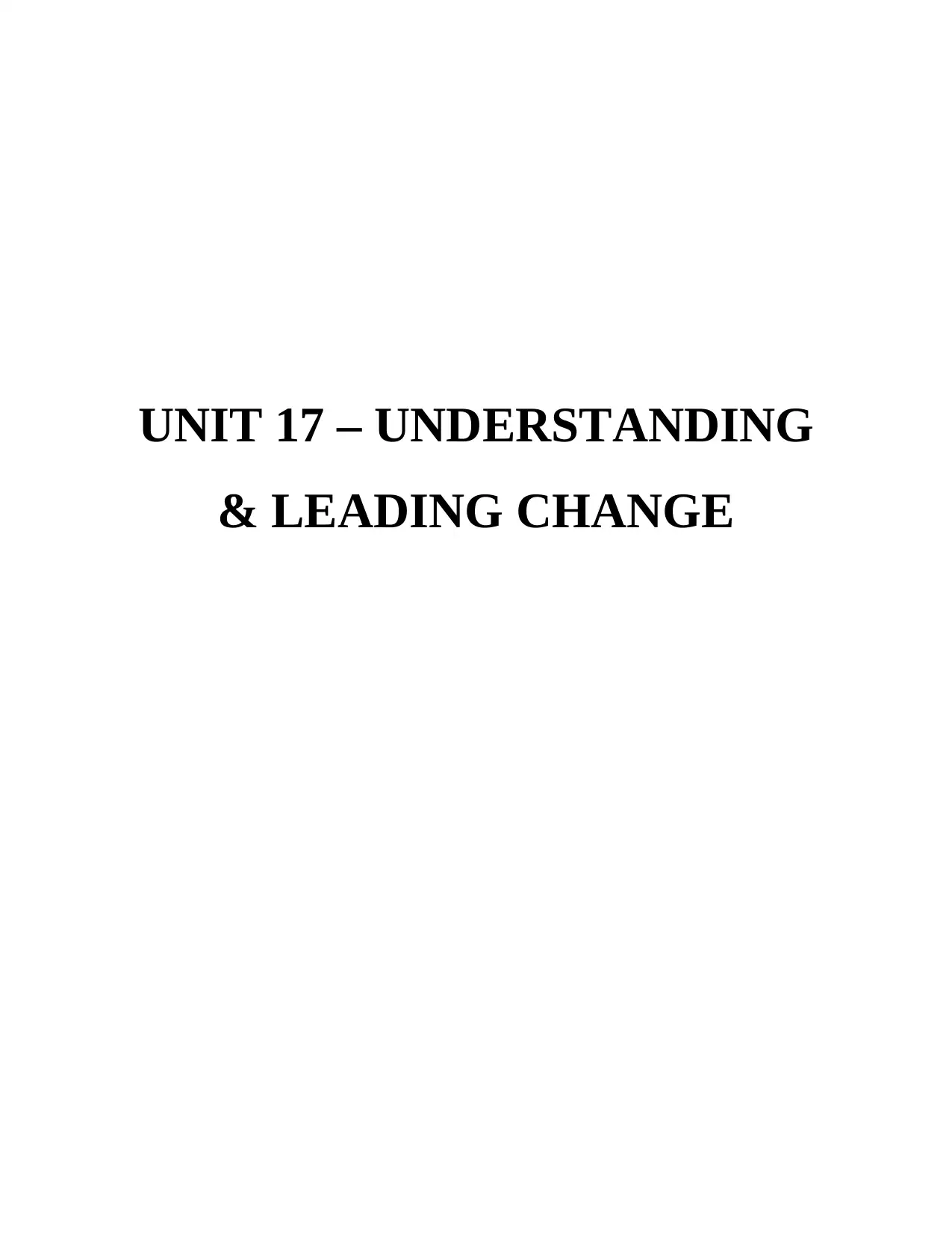
UNIT 17 – UNDERSTANDING
& LEADING CHANGE
& LEADING CHANGE
Paraphrase This Document
Need a fresh take? Get an instant paraphrase of this document with our AI Paraphraser
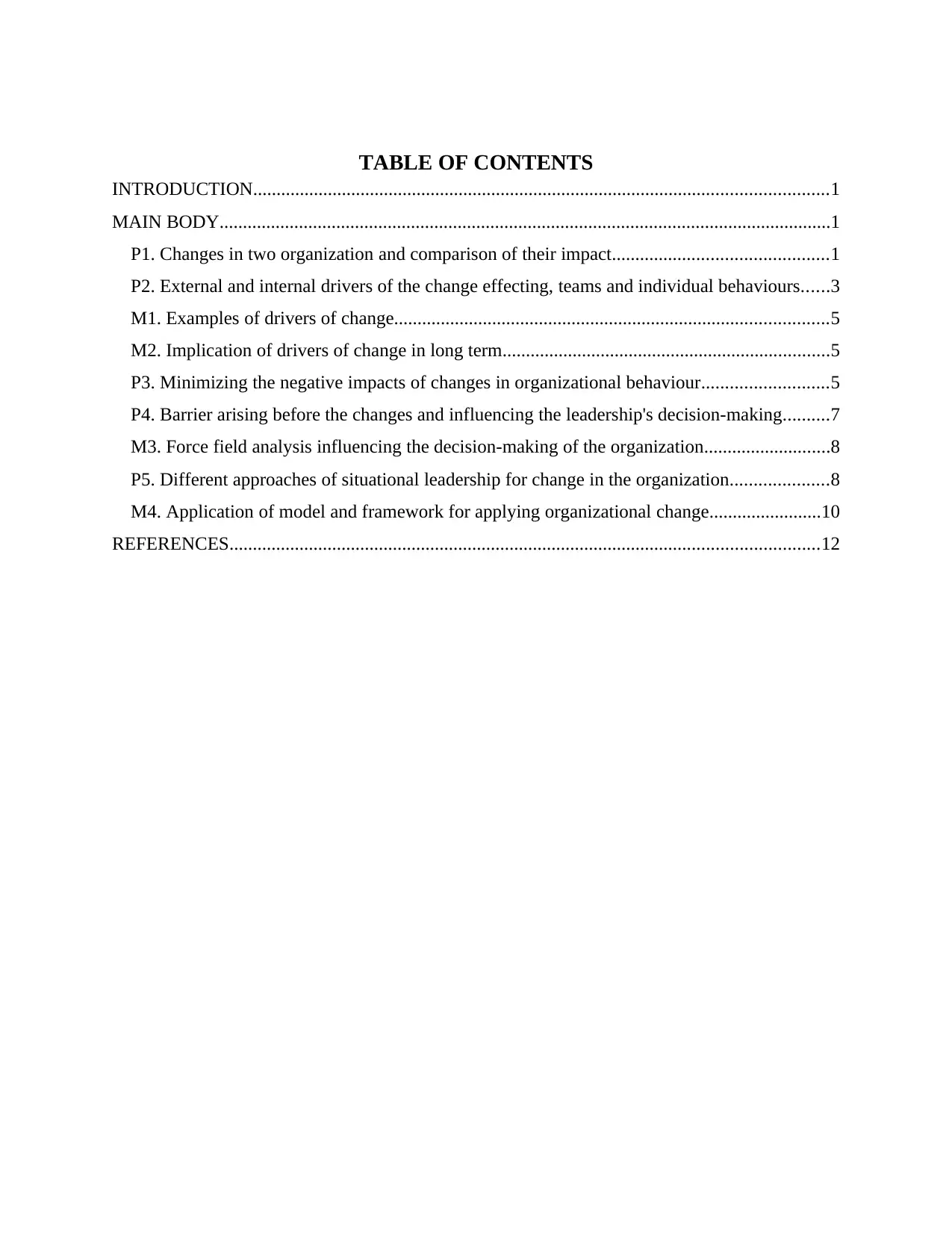
TABLE OF CONTENTS
INTRODUCTION...........................................................................................................................1
MAIN BODY...................................................................................................................................1
P1. Changes in two organization and comparison of their impact..............................................1
P2. External and internal drivers of the change effecting, teams and individual behaviours......3
M1. Examples of drivers of change.............................................................................................5
M2. Implication of drivers of change in long term......................................................................5
P3. Minimizing the negative impacts of changes in organizational behaviour...........................5
P4. Barrier arising before the changes and influencing the leadership's decision-making..........7
M3. Force field analysis influencing the decision-making of the organization...........................8
P5. Different approaches of situational leadership for change in the organization.....................8
M4. Application of model and framework for applying organizational change........................10
REFERENCES..............................................................................................................................12
INTRODUCTION...........................................................................................................................1
MAIN BODY...................................................................................................................................1
P1. Changes in two organization and comparison of their impact..............................................1
P2. External and internal drivers of the change effecting, teams and individual behaviours......3
M1. Examples of drivers of change.............................................................................................5
M2. Implication of drivers of change in long term......................................................................5
P3. Minimizing the negative impacts of changes in organizational behaviour...........................5
P4. Barrier arising before the changes and influencing the leadership's decision-making..........7
M3. Force field analysis influencing the decision-making of the organization...........................8
P5. Different approaches of situational leadership for change in the organization.....................8
M4. Application of model and framework for applying organizational change........................10
REFERENCES..............................................................................................................................12
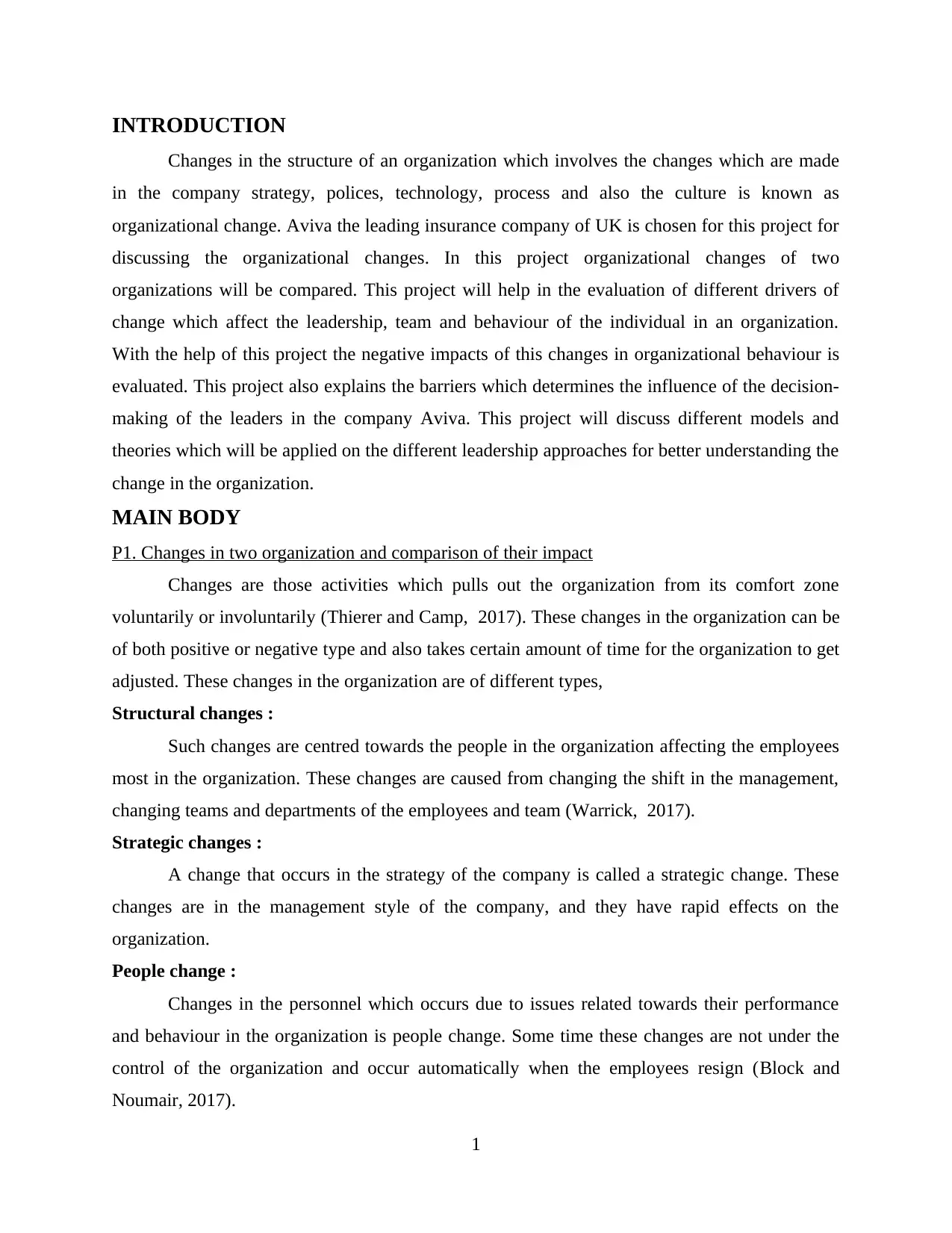
INTRODUCTION
Changes in the structure of an organization which involves the changes which are made
in the company strategy, polices, technology, process and also the culture is known as
organizational change. Aviva the leading insurance company of UK is chosen for this project for
discussing the organizational changes. In this project organizational changes of two
organizations will be compared. This project will help in the evaluation of different drivers of
change which affect the leadership, team and behaviour of the individual in an organization.
With the help of this project the negative impacts of this changes in organizational behaviour is
evaluated. This project also explains the barriers which determines the influence of the decision-
making of the leaders in the company Aviva. This project will discuss different models and
theories which will be applied on the different leadership approaches for better understanding the
change in the organization.
MAIN BODY
P1. Changes in two organization and comparison of their impact
Changes are those activities which pulls out the organization from its comfort zone
voluntarily or involuntarily (Thierer and Camp, 2017). These changes in the organization can be
of both positive or negative type and also takes certain amount of time for the organization to get
adjusted. These changes in the organization are of different types,
Structural changes :
Such changes are centred towards the people in the organization affecting the employees
most in the organization. These changes are caused from changing the shift in the management,
changing teams and departments of the employees and team (Warrick, 2017).
Strategic changes :
A change that occurs in the strategy of the company is called a strategic change. These
changes are in the management style of the company, and they have rapid effects on the
organization.
People change :
Changes in the personnel which occurs due to issues related towards their performance
and behaviour in the organization is people change. Some time these changes are not under the
control of the organization and occur automatically when the employees resign (Block and
Noumair, 2017).
1
Changes in the structure of an organization which involves the changes which are made
in the company strategy, polices, technology, process and also the culture is known as
organizational change. Aviva the leading insurance company of UK is chosen for this project for
discussing the organizational changes. In this project organizational changes of two
organizations will be compared. This project will help in the evaluation of different drivers of
change which affect the leadership, team and behaviour of the individual in an organization.
With the help of this project the negative impacts of this changes in organizational behaviour is
evaluated. This project also explains the barriers which determines the influence of the decision-
making of the leaders in the company Aviva. This project will discuss different models and
theories which will be applied on the different leadership approaches for better understanding the
change in the organization.
MAIN BODY
P1. Changes in two organization and comparison of their impact
Changes are those activities which pulls out the organization from its comfort zone
voluntarily or involuntarily (Thierer and Camp, 2017). These changes in the organization can be
of both positive or negative type and also takes certain amount of time for the organization to get
adjusted. These changes in the organization are of different types,
Structural changes :
Such changes are centred towards the people in the organization affecting the employees
most in the organization. These changes are caused from changing the shift in the management,
changing teams and departments of the employees and team (Warrick, 2017).
Strategic changes :
A change that occurs in the strategy of the company is called a strategic change. These
changes are in the management style of the company, and they have rapid effects on the
organization.
People change :
Changes in the personnel which occurs due to issues related towards their performance
and behaviour in the organization is people change. Some time these changes are not under the
control of the organization and occur automatically when the employees resign (Block and
Noumair, 2017).
1
⊘ This is a preview!⊘
Do you want full access?
Subscribe today to unlock all pages.

Trusted by 1+ million students worldwide
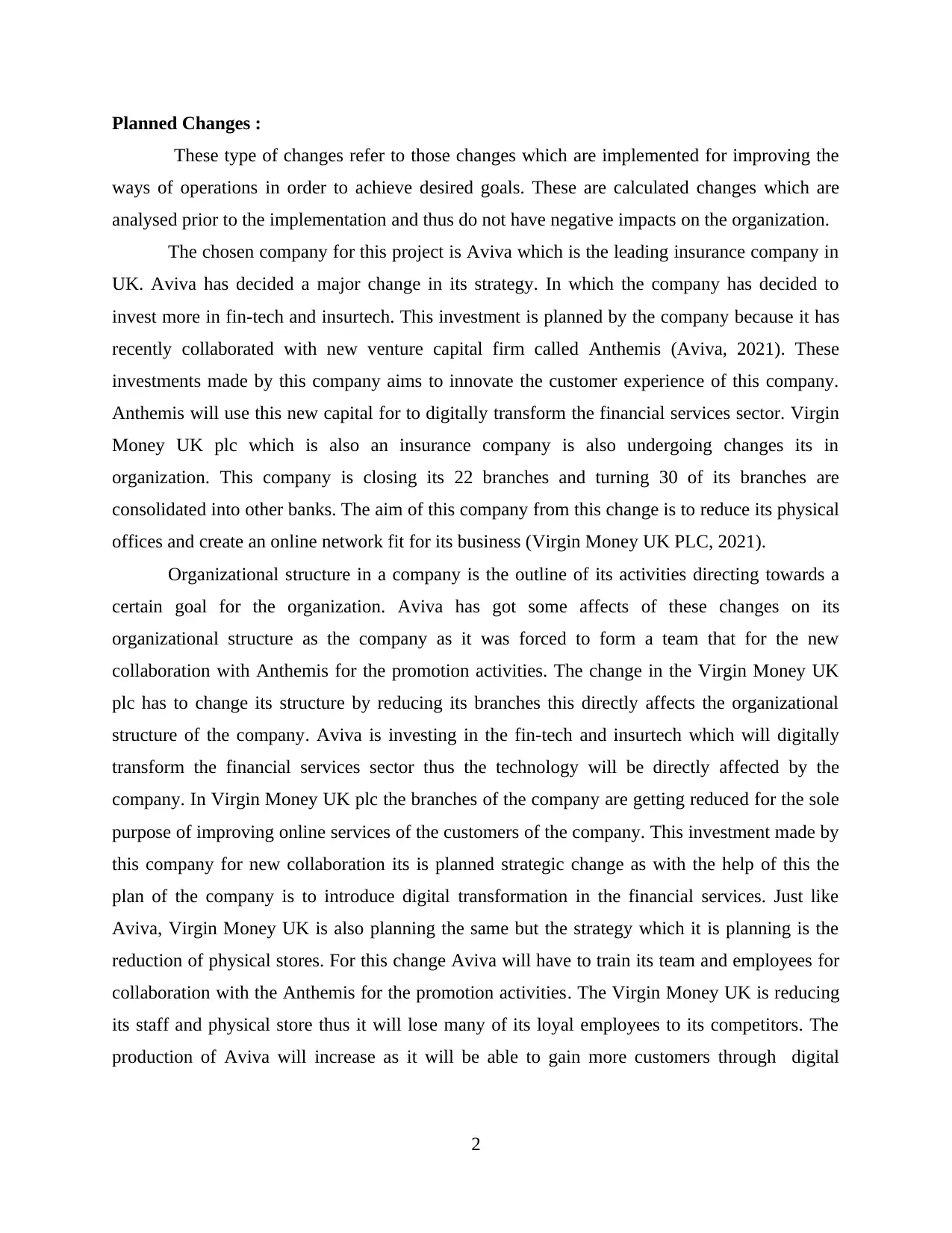
Planned Changes :
These type of changes refer to those changes which are implemented for improving the
ways of operations in order to achieve desired goals. These are calculated changes which are
analysed prior to the implementation and thus do not have negative impacts on the organization.
The chosen company for this project is Aviva which is the leading insurance company in
UK. Aviva has decided a major change in its strategy. In which the company has decided to
invest more in fin-tech and insurtech. This investment is planned by the company because it has
recently collaborated with new venture capital firm called Anthemis (Aviva, 2021). These
investments made by this company aims to innovate the customer experience of this company.
Anthemis will use this new capital for to digitally transform the financial services sector. Virgin
Money UK plc which is also an insurance company is also undergoing changes its in
organization. This company is closing its 22 branches and turning 30 of its branches are
consolidated into other banks. The aim of this company from this change is to reduce its physical
offices and create an online network fit for its business (Virgin Money UK PLC, 2021).
Organizational structure in a company is the outline of its activities directing towards a
certain goal for the organization. Aviva has got some affects of these changes on its
organizational structure as the company as it was forced to form a team that for the new
collaboration with Anthemis for the promotion activities. The change in the Virgin Money UK
plc has to change its structure by reducing its branches this directly affects the organizational
structure of the company. Aviva is investing in the fin-tech and insurtech which will digitally
transform the financial services sector thus the technology will be directly affected by the
company. In Virgin Money UK plc the branches of the company are getting reduced for the sole
purpose of improving online services of the customers of the company. This investment made by
this company for new collaboration its is planned strategic change as with the help of this the
plan of the company is to introduce digital transformation in the financial services. Just like
Aviva, Virgin Money UK is also planning the same but the strategy which it is planning is the
reduction of physical stores. For this change Aviva will have to train its team and employees for
collaboration with the Anthemis for the promotion activities. The Virgin Money UK is reducing
its staff and physical store thus it will lose many of its loyal employees to its competitors. The
production of Aviva will increase as it will be able to gain more customers through digital
2
These type of changes refer to those changes which are implemented for improving the
ways of operations in order to achieve desired goals. These are calculated changes which are
analysed prior to the implementation and thus do not have negative impacts on the organization.
The chosen company for this project is Aviva which is the leading insurance company in
UK. Aviva has decided a major change in its strategy. In which the company has decided to
invest more in fin-tech and insurtech. This investment is planned by the company because it has
recently collaborated with new venture capital firm called Anthemis (Aviva, 2021). These
investments made by this company aims to innovate the customer experience of this company.
Anthemis will use this new capital for to digitally transform the financial services sector. Virgin
Money UK plc which is also an insurance company is also undergoing changes its in
organization. This company is closing its 22 branches and turning 30 of its branches are
consolidated into other banks. The aim of this company from this change is to reduce its physical
offices and create an online network fit for its business (Virgin Money UK PLC, 2021).
Organizational structure in a company is the outline of its activities directing towards a
certain goal for the organization. Aviva has got some affects of these changes on its
organizational structure as the company as it was forced to form a team that for the new
collaboration with Anthemis for the promotion activities. The change in the Virgin Money UK
plc has to change its structure by reducing its branches this directly affects the organizational
structure of the company. Aviva is investing in the fin-tech and insurtech which will digitally
transform the financial services sector thus the technology will be directly affected by the
company. In Virgin Money UK plc the branches of the company are getting reduced for the sole
purpose of improving online services of the customers of the company. This investment made by
this company for new collaboration its is planned strategic change as with the help of this the
plan of the company is to introduce digital transformation in the financial services. Just like
Aviva, Virgin Money UK is also planning the same but the strategy which it is planning is the
reduction of physical stores. For this change Aviva will have to train its team and employees for
collaboration with the Anthemis for the promotion activities. The Virgin Money UK is reducing
its staff and physical store thus it will lose many of its loyal employees to its competitors. The
production of Aviva will increase as it will be able to gain more customers through digital
2
Paraphrase This Document
Need a fresh take? Get an instant paraphrase of this document with our AI Paraphraser
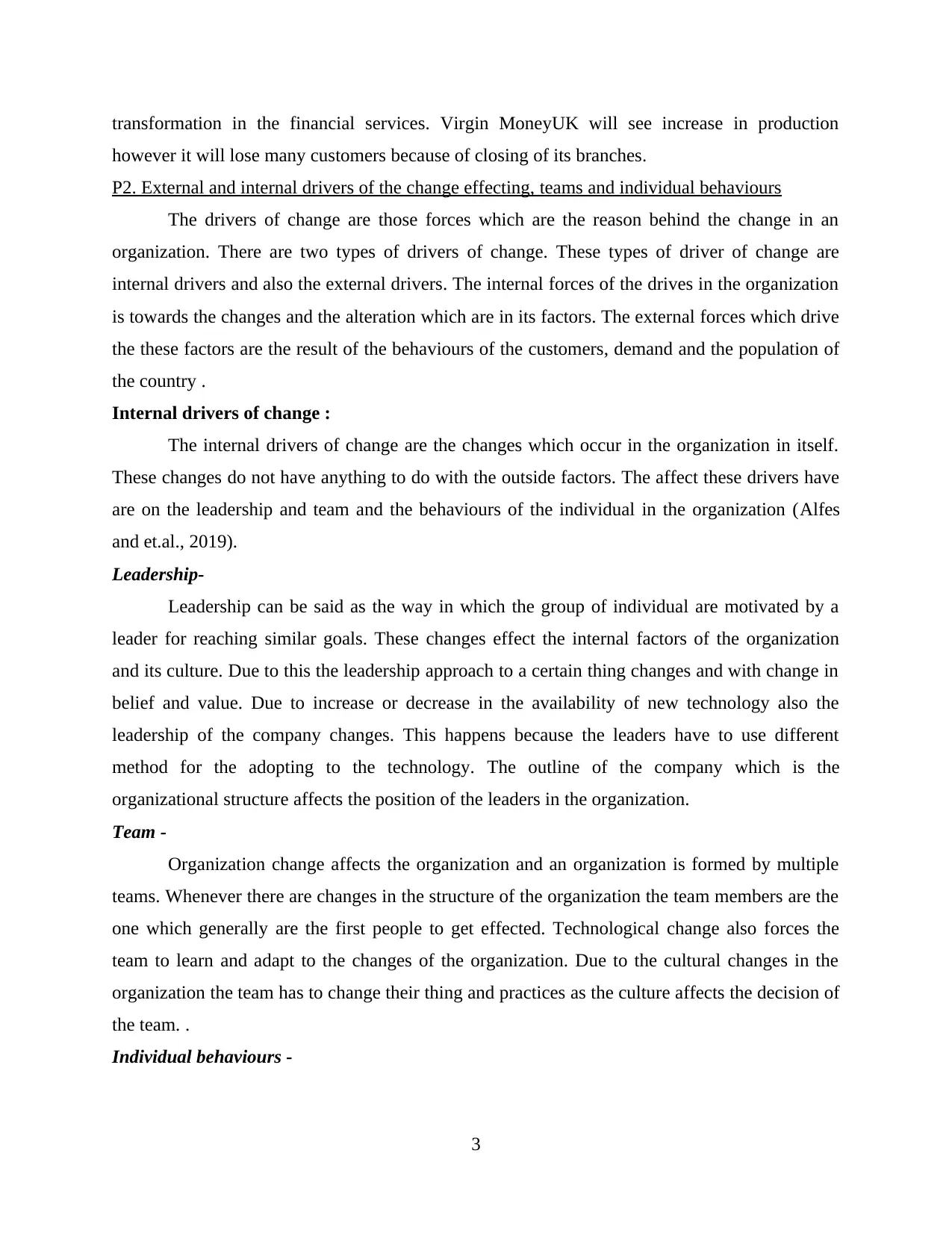
transformation in the financial services. Virgin MoneyUK will see increase in production
however it will lose many customers because of closing of its branches.
P2. External and internal drivers of the change effecting, teams and individual behaviours
The drivers of change are those forces which are the reason behind the change in an
organization. There are two types of drivers of change. These types of driver of change are
internal drivers and also the external drivers. The internal forces of the drives in the organization
is towards the changes and the alteration which are in its factors. The external forces which drive
the these factors are the result of the behaviours of the customers, demand and the population of
the country .
Internal drivers of change :
The internal drivers of change are the changes which occur in the organization in itself.
These changes do not have anything to do with the outside factors. The affect these drivers have
are on the leadership and team and the behaviours of the individual in the organization (Alfes
and et.al., 2019).
Leadership-
Leadership can be said as the way in which the group of individual are motivated by a
leader for reaching similar goals. These changes effect the internal factors of the organization
and its culture. Due to this the leadership approach to a certain thing changes and with change in
belief and value. Due to increase or decrease in the availability of new technology also the
leadership of the company changes. This happens because the leaders have to use different
method for the adopting to the technology. The outline of the company which is the
organizational structure affects the position of the leaders in the organization.
Team -
Organization change affects the organization and an organization is formed by multiple
teams. Whenever there are changes in the structure of the organization the team members are the
one which generally are the first people to get effected. Technological change also forces the
team to learn and adapt to the changes of the organization. Due to the cultural changes in the
organization the team has to change their thing and practices as the culture affects the decision of
the team. .
Individual behaviours -
3
however it will lose many customers because of closing of its branches.
P2. External and internal drivers of the change effecting, teams and individual behaviours
The drivers of change are those forces which are the reason behind the change in an
organization. There are two types of drivers of change. These types of driver of change are
internal drivers and also the external drivers. The internal forces of the drives in the organization
is towards the changes and the alteration which are in its factors. The external forces which drive
the these factors are the result of the behaviours of the customers, demand and the population of
the country .
Internal drivers of change :
The internal drivers of change are the changes which occur in the organization in itself.
These changes do not have anything to do with the outside factors. The affect these drivers have
are on the leadership and team and the behaviours of the individual in the organization (Alfes
and et.al., 2019).
Leadership-
Leadership can be said as the way in which the group of individual are motivated by a
leader for reaching similar goals. These changes effect the internal factors of the organization
and its culture. Due to this the leadership approach to a certain thing changes and with change in
belief and value. Due to increase or decrease in the availability of new technology also the
leadership of the company changes. This happens because the leaders have to use different
method for the adopting to the technology. The outline of the company which is the
organizational structure affects the position of the leaders in the organization.
Team -
Organization change affects the organization and an organization is formed by multiple
teams. Whenever there are changes in the structure of the organization the team members are the
one which generally are the first people to get effected. Technological change also forces the
team to learn and adapt to the changes of the organization. Due to the cultural changes in the
organization the team has to change their thing and practices as the culture affects the decision of
the team. .
Individual behaviours -
3
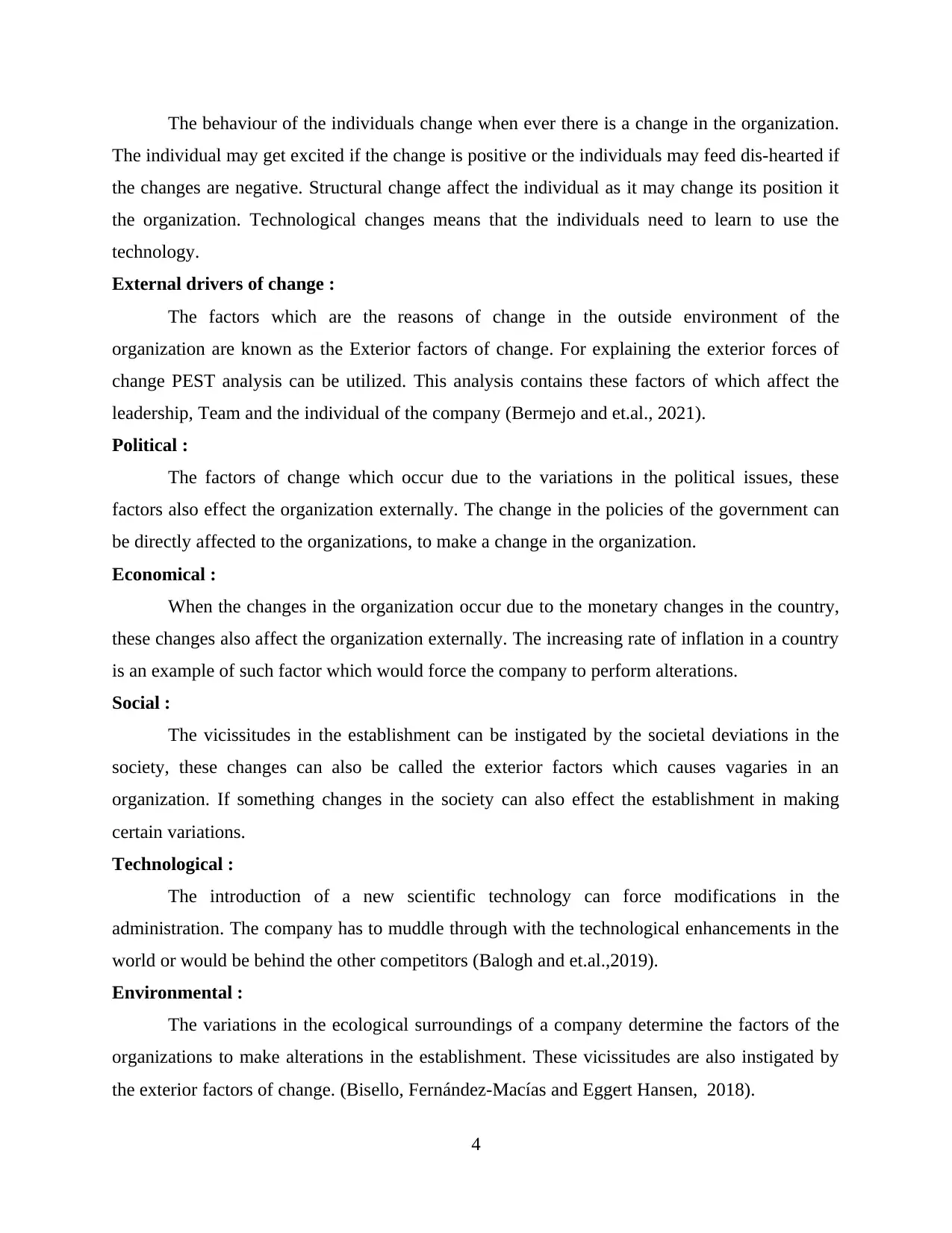
The behaviour of the individuals change when ever there is a change in the organization.
The individual may get excited if the change is positive or the individuals may feed dis-hearted if
the changes are negative. Structural change affect the individual as it may change its position it
the organization. Technological changes means that the individuals need to learn to use the
technology.
External drivers of change :
The factors which are the reasons of change in the outside environment of the
organization are known as the Exterior factors of change. For explaining the exterior forces of
change PEST analysis can be utilized. This analysis contains these factors of which affect the
leadership, Team and the individual of the company (Bermejo and et.al., 2021).
Political :
The factors of change which occur due to the variations in the political issues, these
factors also effect the organization externally. The change in the policies of the government can
be directly affected to the organizations, to make a change in the organization.
Economical :
When the changes in the organization occur due to the monetary changes in the country,
these changes also affect the organization externally. The increasing rate of inflation in a country
is an example of such factor which would force the company to perform alterations.
Social :
The vicissitudes in the establishment can be instigated by the societal deviations in the
society, these changes can also be called the exterior factors which causes vagaries in an
organization. If something changes in the society can also effect the establishment in making
certain variations.
Technological :
The introduction of a new scientific technology can force modifications in the
administration. The company has to muddle through with the technological enhancements in the
world or would be behind the other competitors (Balogh and et.al.,2019).
Environmental :
The variations in the ecological surroundings of a company determine the factors of the
organizations to make alterations in the establishment. These vicissitudes are also instigated by
the exterior factors of change. (Bisello, Fernández-Macías and Eggert Hansen, 2018).
4
The individual may get excited if the change is positive or the individuals may feed dis-hearted if
the changes are negative. Structural change affect the individual as it may change its position it
the organization. Technological changes means that the individuals need to learn to use the
technology.
External drivers of change :
The factors which are the reasons of change in the outside environment of the
organization are known as the Exterior factors of change. For explaining the exterior forces of
change PEST analysis can be utilized. This analysis contains these factors of which affect the
leadership, Team and the individual of the company (Bermejo and et.al., 2021).
Political :
The factors of change which occur due to the variations in the political issues, these
factors also effect the organization externally. The change in the policies of the government can
be directly affected to the organizations, to make a change in the organization.
Economical :
When the changes in the organization occur due to the monetary changes in the country,
these changes also affect the organization externally. The increasing rate of inflation in a country
is an example of such factor which would force the company to perform alterations.
Social :
The vicissitudes in the establishment can be instigated by the societal deviations in the
society, these changes can also be called the exterior factors which causes vagaries in an
organization. If something changes in the society can also effect the establishment in making
certain variations.
Technological :
The introduction of a new scientific technology can force modifications in the
administration. The company has to muddle through with the technological enhancements in the
world or would be behind the other competitors (Balogh and et.al.,2019).
Environmental :
The variations in the ecological surroundings of a company determine the factors of the
organizations to make alterations in the establishment. These vicissitudes are also instigated by
the exterior factors of change. (Bisello, Fernández-Macías and Eggert Hansen, 2018).
4
⊘ This is a preview!⊘
Do you want full access?
Subscribe today to unlock all pages.

Trusted by 1+ million students worldwide
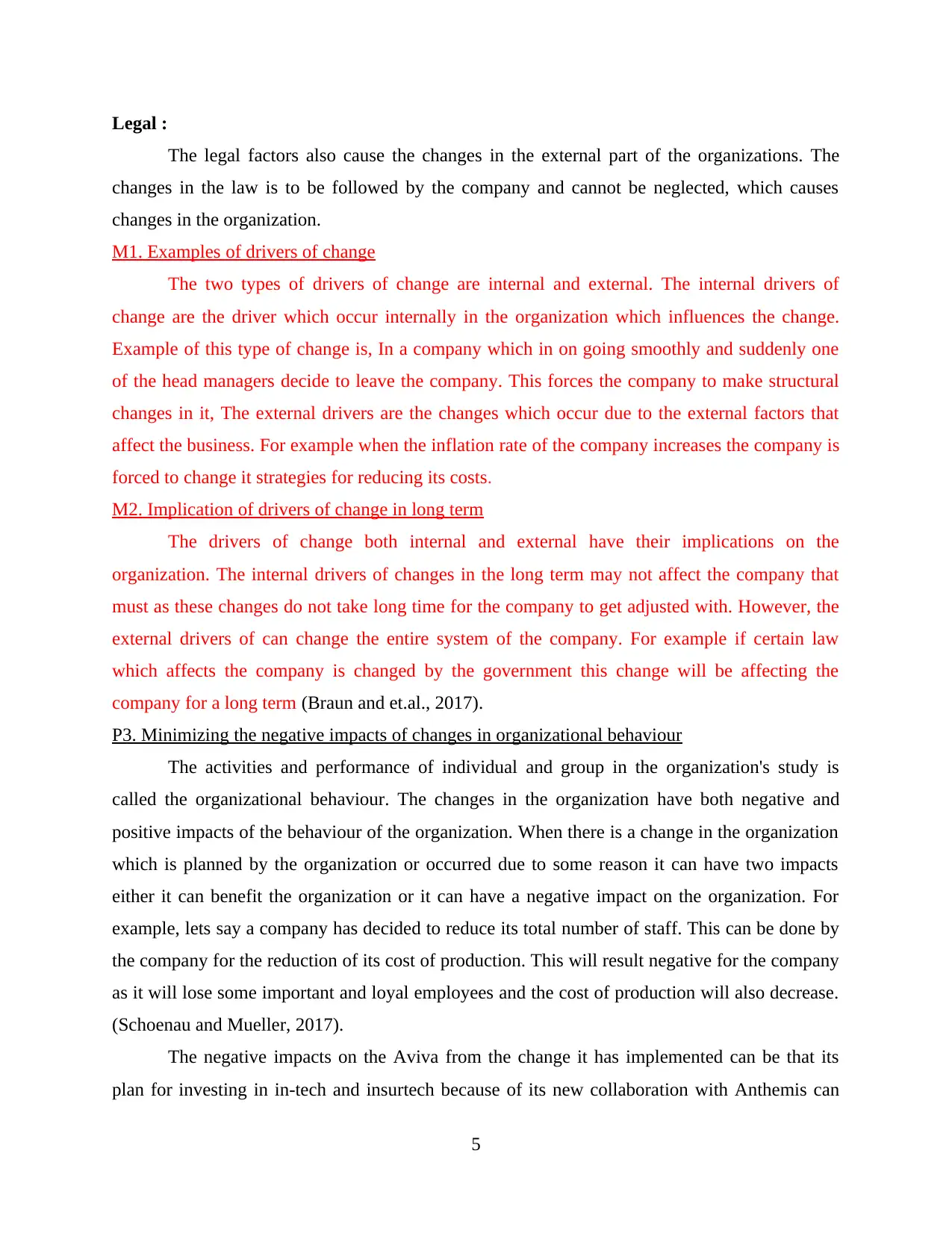
Legal :
The legal factors also cause the changes in the external part of the organizations. The
changes in the law is to be followed by the company and cannot be neglected, which causes
changes in the organization.
M1. Examples of drivers of change
The two types of drivers of change are internal and external. The internal drivers of
change are the driver which occur internally in the organization which influences the change.
Example of this type of change is, In a company which in on going smoothly and suddenly one
of the head managers decide to leave the company. This forces the company to make structural
changes in it, The external drivers are the changes which occur due to the external factors that
affect the business. For example when the inflation rate of the company increases the company is
forced to change it strategies for reducing its costs.
M2. Implication of drivers of change in long term
The drivers of change both internal and external have their implications on the
organization. The internal drivers of changes in the long term may not affect the company that
must as these changes do not take long time for the company to get adjusted with. However, the
external drivers of can change the entire system of the company. For example if certain law
which affects the company is changed by the government this change will be affecting the
company for a long term (Braun and et.al., 2017).
P3. Minimizing the negative impacts of changes in organizational behaviour
The activities and performance of individual and group in the organization's study is
called the organizational behaviour. The changes in the organization have both negative and
positive impacts of the behaviour of the organization. When there is a change in the organization
which is planned by the organization or occurred due to some reason it can have two impacts
either it can benefit the organization or it can have a negative impact on the organization. For
example, lets say a company has decided to reduce its total number of staff. This can be done by
the company for the reduction of its cost of production. This will result negative for the company
as it will lose some important and loyal employees and the cost of production will also decrease.
(Schoenau and Mueller, 2017).
The negative impacts on the Aviva from the change it has implemented can be that its
plan for investing in in-tech and insurtech because of its new collaboration with Anthemis can
5
The legal factors also cause the changes in the external part of the organizations. The
changes in the law is to be followed by the company and cannot be neglected, which causes
changes in the organization.
M1. Examples of drivers of change
The two types of drivers of change are internal and external. The internal drivers of
change are the driver which occur internally in the organization which influences the change.
Example of this type of change is, In a company which in on going smoothly and suddenly one
of the head managers decide to leave the company. This forces the company to make structural
changes in it, The external drivers are the changes which occur due to the external factors that
affect the business. For example when the inflation rate of the company increases the company is
forced to change it strategies for reducing its costs.
M2. Implication of drivers of change in long term
The drivers of change both internal and external have their implications on the
organization. The internal drivers of changes in the long term may not affect the company that
must as these changes do not take long time for the company to get adjusted with. However, the
external drivers of can change the entire system of the company. For example if certain law
which affects the company is changed by the government this change will be affecting the
company for a long term (Braun and et.al., 2017).
P3. Minimizing the negative impacts of changes in organizational behaviour
The activities and performance of individual and group in the organization's study is
called the organizational behaviour. The changes in the organization have both negative and
positive impacts of the behaviour of the organization. When there is a change in the organization
which is planned by the organization or occurred due to some reason it can have two impacts
either it can benefit the organization or it can have a negative impact on the organization. For
example, lets say a company has decided to reduce its total number of staff. This can be done by
the company for the reduction of its cost of production. This will result negative for the company
as it will lose some important and loyal employees and the cost of production will also decrease.
(Schoenau and Mueller, 2017).
The negative impacts on the Aviva from the change it has implemented can be that its
plan for investing in in-tech and insurtech because of its new collaboration with Anthemis can
5
Paraphrase This Document
Need a fresh take? Get an instant paraphrase of this document with our AI Paraphraser
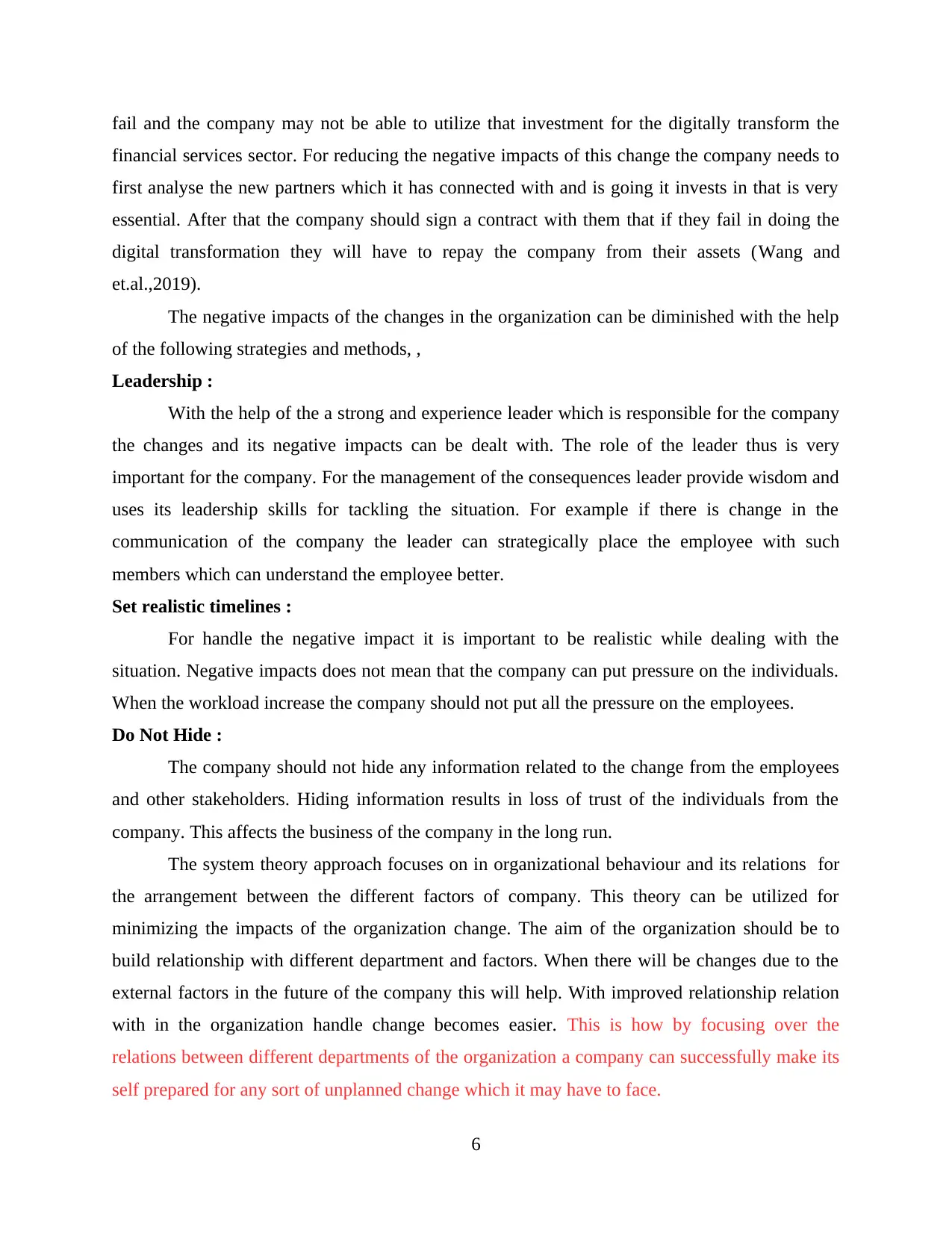
fail and the company may not be able to utilize that investment for the digitally transform the
financial services sector. For reducing the negative impacts of this change the company needs to
first analyse the new partners which it has connected with and is going it invests in that is very
essential. After that the company should sign a contract with them that if they fail in doing the
digital transformation they will have to repay the company from their assets (Wang and
et.al.,2019).
The negative impacts of the changes in the organization can be diminished with the help
of the following strategies and methods, ,
Leadership :
With the help of the a strong and experience leader which is responsible for the company
the changes and its negative impacts can be dealt with. The role of the leader thus is very
important for the company. For the management of the consequences leader provide wisdom and
uses its leadership skills for tackling the situation. For example if there is change in the
communication of the company the leader can strategically place the employee with such
members which can understand the employee better.
Set realistic timelines :
For handle the negative impact it is important to be realistic while dealing with the
situation. Negative impacts does not mean that the company can put pressure on the individuals.
When the workload increase the company should not put all the pressure on the employees.
Do Not Hide :
The company should not hide any information related to the change from the employees
and other stakeholders. Hiding information results in loss of trust of the individuals from the
company. This affects the business of the company in the long run.
The system theory approach focuses on in organizational behaviour and its relations for
the arrangement between the different factors of company. This theory can be utilized for
minimizing the impacts of the organization change. The aim of the organization should be to
build relationship with different department and factors. When there will be changes due to the
external factors in the future of the company this will help. With improved relationship relation
with in the organization handle change becomes easier. This is how by focusing over the
relations between different departments of the organization a company can successfully make its
self prepared for any sort of unplanned change which it may have to face.
6
financial services sector. For reducing the negative impacts of this change the company needs to
first analyse the new partners which it has connected with and is going it invests in that is very
essential. After that the company should sign a contract with them that if they fail in doing the
digital transformation they will have to repay the company from their assets (Wang and
et.al.,2019).
The negative impacts of the changes in the organization can be diminished with the help
of the following strategies and methods, ,
Leadership :
With the help of the a strong and experience leader which is responsible for the company
the changes and its negative impacts can be dealt with. The role of the leader thus is very
important for the company. For the management of the consequences leader provide wisdom and
uses its leadership skills for tackling the situation. For example if there is change in the
communication of the company the leader can strategically place the employee with such
members which can understand the employee better.
Set realistic timelines :
For handle the negative impact it is important to be realistic while dealing with the
situation. Negative impacts does not mean that the company can put pressure on the individuals.
When the workload increase the company should not put all the pressure on the employees.
Do Not Hide :
The company should not hide any information related to the change from the employees
and other stakeholders. Hiding information results in loss of trust of the individuals from the
company. This affects the business of the company in the long run.
The system theory approach focuses on in organizational behaviour and its relations for
the arrangement between the different factors of company. This theory can be utilized for
minimizing the impacts of the organization change. The aim of the organization should be to
build relationship with different department and factors. When there will be changes due to the
external factors in the future of the company this will help. With improved relationship relation
with in the organization handle change becomes easier. This is how by focusing over the
relations between different departments of the organization a company can successfully make its
self prepared for any sort of unplanned change which it may have to face.
6
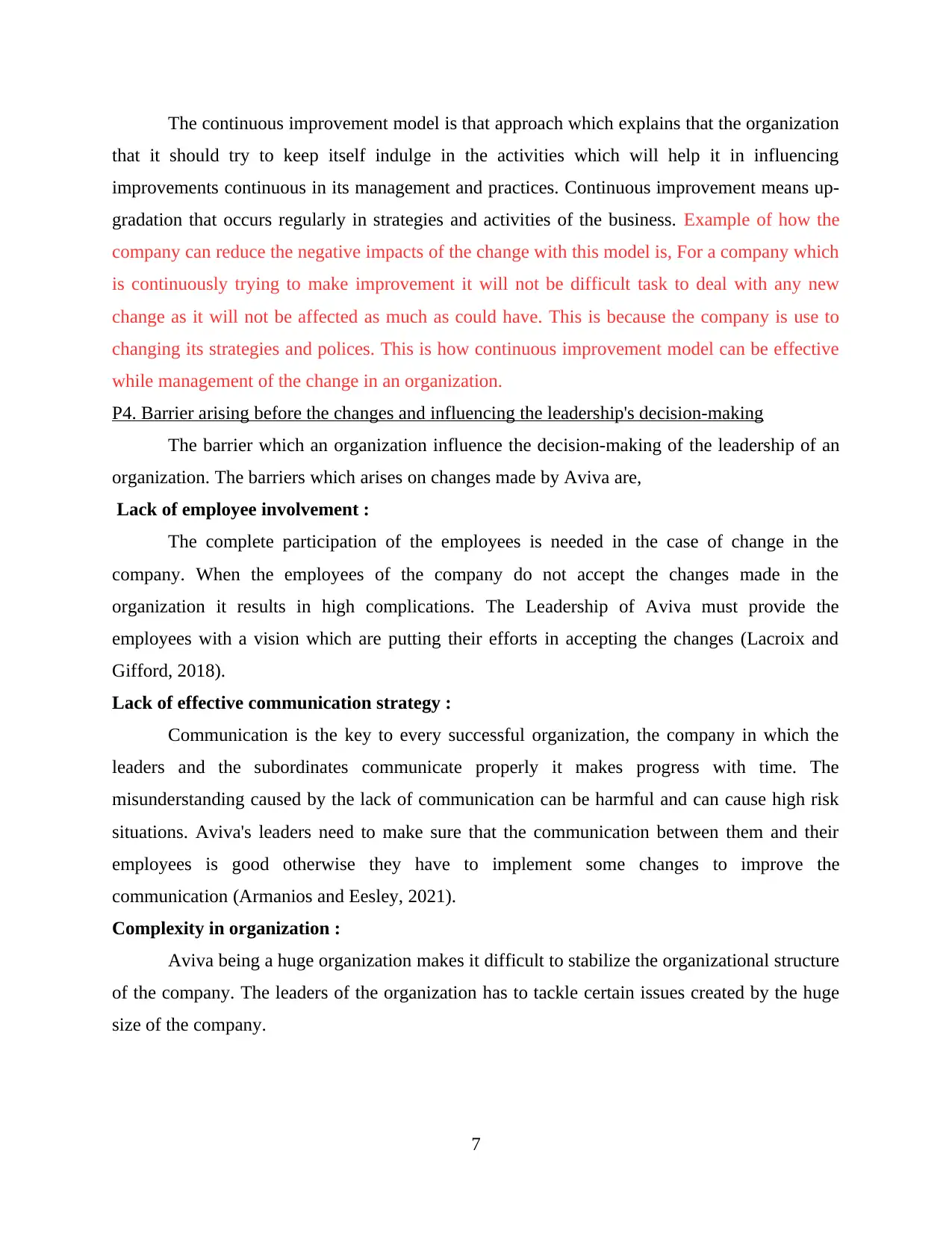
The continuous improvement model is that approach which explains that the organization
that it should try to keep itself indulge in the activities which will help it in influencing
improvements continuous in its management and practices. Continuous improvement means up-
gradation that occurs regularly in strategies and activities of the business. Example of how the
company can reduce the negative impacts of the change with this model is, For a company which
is continuously trying to make improvement it will not be difficult task to deal with any new
change as it will not be affected as much as could have. This is because the company is use to
changing its strategies and polices. This is how continuous improvement model can be effective
while management of the change in an organization.
P4. Barrier arising before the changes and influencing the leadership's decision-making
The barrier which an organization influence the decision-making of the leadership of an
organization. The barriers which arises on changes made by Aviva are,
Lack of employee involvement :
The complete participation of the employees is needed in the case of change in the
company. When the employees of the company do not accept the changes made in the
organization it results in high complications. The Leadership of Aviva must provide the
employees with a vision which are putting their efforts in accepting the changes (Lacroix and
Gifford, 2018).
Lack of effective communication strategy :
Communication is the key to every successful organization, the company in which the
leaders and the subordinates communicate properly it makes progress with time. The
misunderstanding caused by the lack of communication can be harmful and can cause high risk
situations. Aviva's leaders need to make sure that the communication between them and their
employees is good otherwise they have to implement some changes to improve the
communication (Armanios and Eesley, 2021).
Complexity in organization :
Aviva being a huge organization makes it difficult to stabilize the organizational structure
of the company. The leaders of the organization has to tackle certain issues created by the huge
size of the company.
7
that it should try to keep itself indulge in the activities which will help it in influencing
improvements continuous in its management and practices. Continuous improvement means up-
gradation that occurs regularly in strategies and activities of the business. Example of how the
company can reduce the negative impacts of the change with this model is, For a company which
is continuously trying to make improvement it will not be difficult task to deal with any new
change as it will not be affected as much as could have. This is because the company is use to
changing its strategies and polices. This is how continuous improvement model can be effective
while management of the change in an organization.
P4. Barrier arising before the changes and influencing the leadership's decision-making
The barrier which an organization influence the decision-making of the leadership of an
organization. The barriers which arises on changes made by Aviva are,
Lack of employee involvement :
The complete participation of the employees is needed in the case of change in the
company. When the employees of the company do not accept the changes made in the
organization it results in high complications. The Leadership of Aviva must provide the
employees with a vision which are putting their efforts in accepting the changes (Lacroix and
Gifford, 2018).
Lack of effective communication strategy :
Communication is the key to every successful organization, the company in which the
leaders and the subordinates communicate properly it makes progress with time. The
misunderstanding caused by the lack of communication can be harmful and can cause high risk
situations. Aviva's leaders need to make sure that the communication between them and their
employees is good otherwise they have to implement some changes to improve the
communication (Armanios and Eesley, 2021).
Complexity in organization :
Aviva being a huge organization makes it difficult to stabilize the organizational structure
of the company. The leaders of the organization has to tackle certain issues created by the huge
size of the company.
7
⊘ This is a preview!⊘
Do you want full access?
Subscribe today to unlock all pages.

Trusted by 1+ million students worldwide
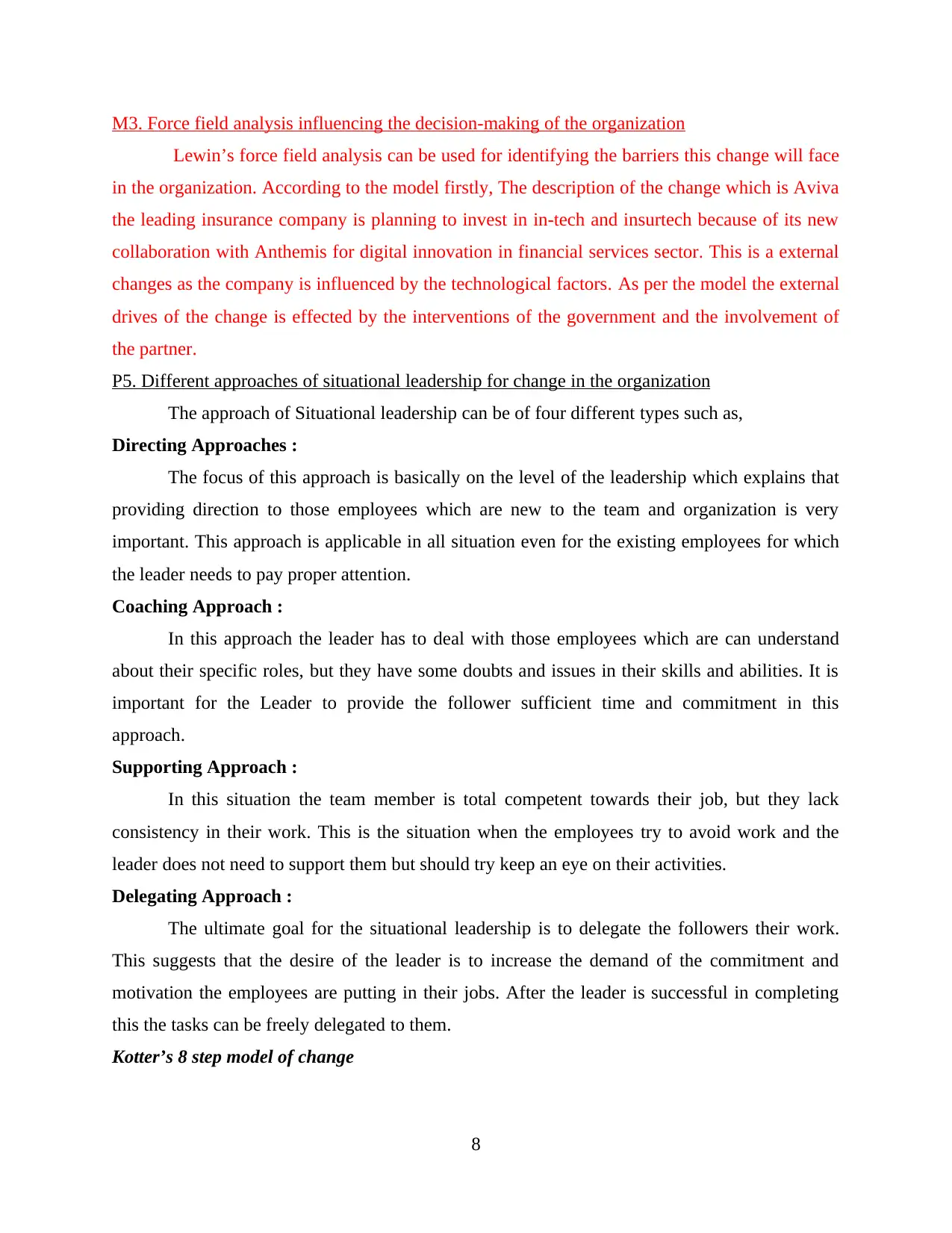
M3. Force field analysis influencing the decision-making of the organization
Lewin’s force field analysis can be used for identifying the barriers this change will face
in the organization. According to the model firstly, The description of the change which is Aviva
the leading insurance company is planning to invest in in-tech and insurtech because of its new
collaboration with Anthemis for digital innovation in financial services sector. This is a external
changes as the company is influenced by the technological factors. As per the model the external
drives of the change is effected by the interventions of the government and the involvement of
the partner.
P5. Different approaches of situational leadership for change in the organization
The approach of Situational leadership can be of four different types such as,
Directing Approaches :
The focus of this approach is basically on the level of the leadership which explains that
providing direction to those employees which are new to the team and organization is very
important. This approach is applicable in all situation even for the existing employees for which
the leader needs to pay proper attention.
Coaching Approach :
In this approach the leader has to deal with those employees which are can understand
about their specific roles, but they have some doubts and issues in their skills and abilities. It is
important for the Leader to provide the follower sufficient time and commitment in this
approach.
Supporting Approach :
In this situation the team member is total competent towards their job, but they lack
consistency in their work. This is the situation when the employees try to avoid work and the
leader does not need to support them but should try keep an eye on their activities.
Delegating Approach :
The ultimate goal for the situational leadership is to delegate the followers their work.
This suggests that the desire of the leader is to increase the demand of the commitment and
motivation the employees are putting in their jobs. After the leader is successful in completing
this the tasks can be freely delegated to them.
Kotter’s 8 step model of change
8
Lewin’s force field analysis can be used for identifying the barriers this change will face
in the organization. According to the model firstly, The description of the change which is Aviva
the leading insurance company is planning to invest in in-tech and insurtech because of its new
collaboration with Anthemis for digital innovation in financial services sector. This is a external
changes as the company is influenced by the technological factors. As per the model the external
drives of the change is effected by the interventions of the government and the involvement of
the partner.
P5. Different approaches of situational leadership for change in the organization
The approach of Situational leadership can be of four different types such as,
Directing Approaches :
The focus of this approach is basically on the level of the leadership which explains that
providing direction to those employees which are new to the team and organization is very
important. This approach is applicable in all situation even for the existing employees for which
the leader needs to pay proper attention.
Coaching Approach :
In this approach the leader has to deal with those employees which are can understand
about their specific roles, but they have some doubts and issues in their skills and abilities. It is
important for the Leader to provide the follower sufficient time and commitment in this
approach.
Supporting Approach :
In this situation the team member is total competent towards their job, but they lack
consistency in their work. This is the situation when the employees try to avoid work and the
leader does not need to support them but should try keep an eye on their activities.
Delegating Approach :
The ultimate goal for the situational leadership is to delegate the followers their work.
This suggests that the desire of the leader is to increase the demand of the commitment and
motivation the employees are putting in their jobs. After the leader is successful in completing
this the tasks can be freely delegated to them.
Kotter’s 8 step model of change
8
Paraphrase This Document
Need a fresh take? Get an instant paraphrase of this document with our AI Paraphraser
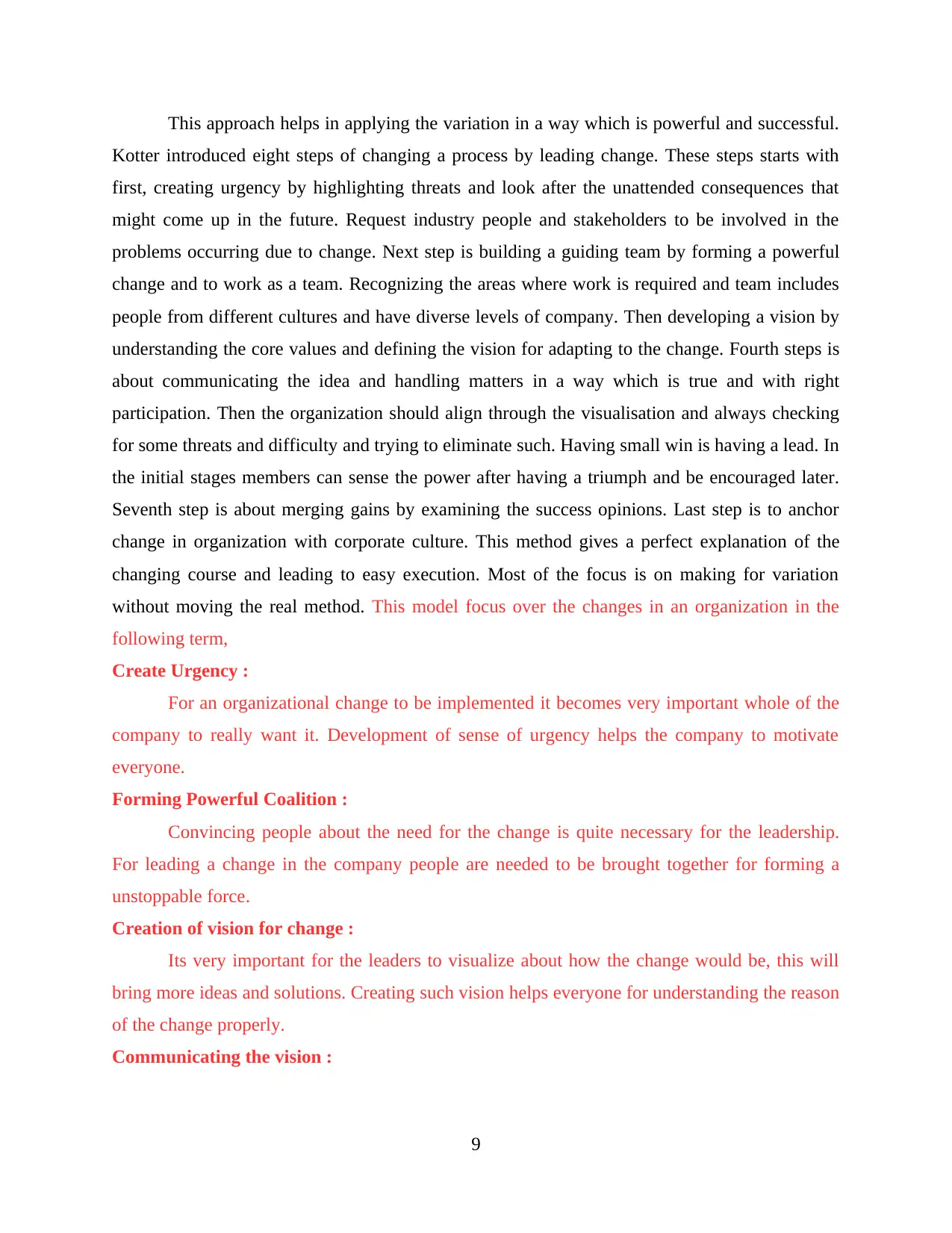
This approach helps in applying the variation in a way which is powerful and successful.
Kotter introduced eight steps of changing a process by leading change. These steps starts with
first, creating urgency by highlighting threats and look after the unattended consequences that
might come up in the future. Request industry people and stakeholders to be involved in the
problems occurring due to change. Next step is building a guiding team by forming a powerful
change and to work as a team. Recognizing the areas where work is required and team includes
people from different cultures and have diverse levels of company. Then developing a vision by
understanding the core values and defining the vision for adapting to the change. Fourth steps is
about communicating the idea and handling matters in a way which is true and with right
participation. Then the organization should align through the visualisation and always checking
for some threats and difficulty and trying to eliminate such. Having small win is having a lead. In
the initial stages members can sense the power after having a triumph and be encouraged later.
Seventh step is about merging gains by examining the success opinions. Last step is to anchor
change in organization with corporate culture. This method gives a perfect explanation of the
changing course and leading to easy execution. Most of the focus is on making for variation
without moving the real method. This model focus over the changes in an organization in the
following term,
Create Urgency :
For an organizational change to be implemented it becomes very important whole of the
company to really want it. Development of sense of urgency helps the company to motivate
everyone.
Forming Powerful Coalition :
Convincing people about the need for the change is quite necessary for the leadership.
For leading a change in the company people are needed to be brought together for forming a
unstoppable force.
Creation of vision for change :
Its very important for the leaders to visualize about how the change would be, this will
bring more ideas and solutions. Creating such vision helps everyone for understanding the reason
of the change properly.
Communicating the vision :
9
Kotter introduced eight steps of changing a process by leading change. These steps starts with
first, creating urgency by highlighting threats and look after the unattended consequences that
might come up in the future. Request industry people and stakeholders to be involved in the
problems occurring due to change. Next step is building a guiding team by forming a powerful
change and to work as a team. Recognizing the areas where work is required and team includes
people from different cultures and have diverse levels of company. Then developing a vision by
understanding the core values and defining the vision for adapting to the change. Fourth steps is
about communicating the idea and handling matters in a way which is true and with right
participation. Then the organization should align through the visualisation and always checking
for some threats and difficulty and trying to eliminate such. Having small win is having a lead. In
the initial stages members can sense the power after having a triumph and be encouraged later.
Seventh step is about merging gains by examining the success opinions. Last step is to anchor
change in organization with corporate culture. This method gives a perfect explanation of the
changing course and leading to easy execution. Most of the focus is on making for variation
without moving the real method. This model focus over the changes in an organization in the
following term,
Create Urgency :
For an organizational change to be implemented it becomes very important whole of the
company to really want it. Development of sense of urgency helps the company to motivate
everyone.
Forming Powerful Coalition :
Convincing people about the need for the change is quite necessary for the leadership.
For leading a change in the company people are needed to be brought together for forming a
unstoppable force.
Creation of vision for change :
Its very important for the leaders to visualize about how the change would be, this will
bring more ideas and solutions. Creating such vision helps everyone for understanding the reason
of the change properly.
Communicating the vision :
9
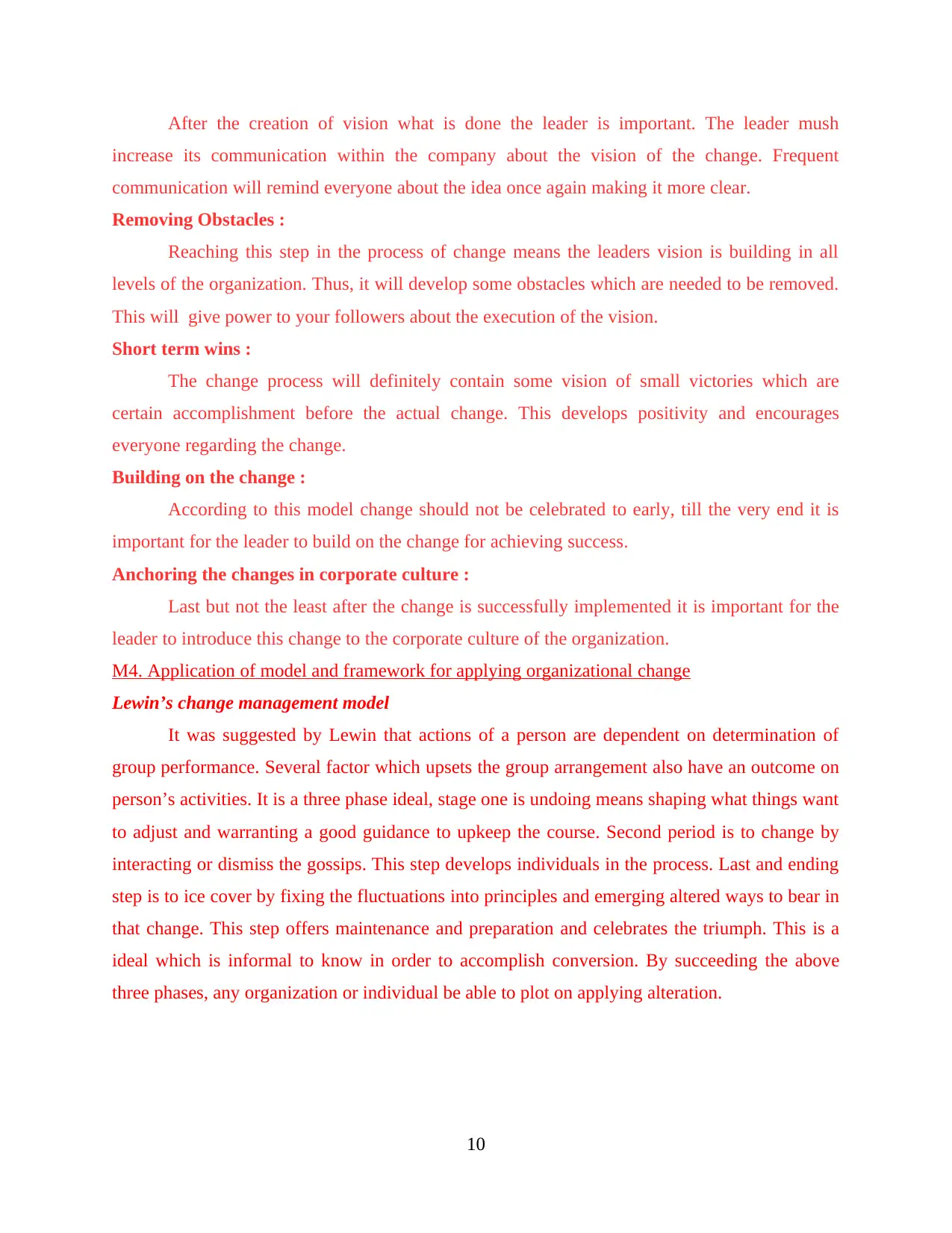
After the creation of vision what is done the leader is important. The leader mush
increase its communication within the company about the vision of the change. Frequent
communication will remind everyone about the idea once again making it more clear.
Removing Obstacles :
Reaching this step in the process of change means the leaders vision is building in all
levels of the organization. Thus, it will develop some obstacles which are needed to be removed.
This will give power to your followers about the execution of the vision.
Short term wins :
The change process will definitely contain some vision of small victories which are
certain accomplishment before the actual change. This develops positivity and encourages
everyone regarding the change.
Building on the change :
According to this model change should not be celebrated to early, till the very end it is
important for the leader to build on the change for achieving success.
Anchoring the changes in corporate culture :
Last but not the least after the change is successfully implemented it is important for the
leader to introduce this change to the corporate culture of the organization.
M4. Application of model and framework for applying organizational change
Lewin’s change management model
It was suggested by Lewin that actions of a person are dependent on determination of
group performance. Several factor which upsets the group arrangement also have an outcome on
person’s activities. It is a three phase ideal, stage one is undoing means shaping what things want
to adjust and warranting a good guidance to upkeep the course. Second period is to change by
interacting or dismiss the gossips. This step develops individuals in the process. Last and ending
step is to ice cover by fixing the fluctuations into principles and emerging altered ways to bear in
that change. This step offers maintenance and preparation and celebrates the triumph. This is a
ideal which is informal to know in order to accomplish conversion. By succeeding the above
three phases, any organization or individual be able to plot on applying alteration.
10
increase its communication within the company about the vision of the change. Frequent
communication will remind everyone about the idea once again making it more clear.
Removing Obstacles :
Reaching this step in the process of change means the leaders vision is building in all
levels of the organization. Thus, it will develop some obstacles which are needed to be removed.
This will give power to your followers about the execution of the vision.
Short term wins :
The change process will definitely contain some vision of small victories which are
certain accomplishment before the actual change. This develops positivity and encourages
everyone regarding the change.
Building on the change :
According to this model change should not be celebrated to early, till the very end it is
important for the leader to build on the change for achieving success.
Anchoring the changes in corporate culture :
Last but not the least after the change is successfully implemented it is important for the
leader to introduce this change to the corporate culture of the organization.
M4. Application of model and framework for applying organizational change
Lewin’s change management model
It was suggested by Lewin that actions of a person are dependent on determination of
group performance. Several factor which upsets the group arrangement also have an outcome on
person’s activities. It is a three phase ideal, stage one is undoing means shaping what things want
to adjust and warranting a good guidance to upkeep the course. Second period is to change by
interacting or dismiss the gossips. This step develops individuals in the process. Last and ending
step is to ice cover by fixing the fluctuations into principles and emerging altered ways to bear in
that change. This step offers maintenance and preparation and celebrates the triumph. This is a
ideal which is informal to know in order to accomplish conversion. By succeeding the above
three phases, any organization or individual be able to plot on applying alteration.
10
⊘ This is a preview!⊘
Do you want full access?
Subscribe today to unlock all pages.

Trusted by 1+ million students worldwide
1 out of 14
Related Documents
Your All-in-One AI-Powered Toolkit for Academic Success.
+13062052269
info@desklib.com
Available 24*7 on WhatsApp / Email
![[object Object]](/_next/static/media/star-bottom.7253800d.svg)
Unlock your academic potential
Copyright © 2020–2025 A2Z Services. All Rights Reserved. Developed and managed by ZUCOL.





